
Orchidaceae, commonly called the orchid family, is a diverse and widespread family of flowering plants, with blooms that are often colourful and fragrant.

Hover flies, also called flower flies or syrphid flies, make up the insect family Syrphidae. As their common name suggests, they are often seen hovering or nectaring at flowers; the adults of many species feed mainly on nectar and pollen, while the larvae (maggots) eat a wide range of foods. In some species, the larvae are saprotrophs, eating decaying plant and animal matter in the soil or in ponds and streams. In other species, the larvae are insectivores and prey on aphids, thrips, and other plant-sucking insects.

Cypripedioideae is a subfamily of orchids commonly known as lady's slipper orchids, lady slipper orchids or slipper orchids. Cypripedioideae includes the genera Cypripedium, Mexipedium, Paphiopedilum, Phragmipedium and Selenipedium. They are characterised by the slipper-shaped pouches of the flowers – the pouch traps insects so they are forced to climb up past the staminode, behind which they collect or deposit pollinia, thus fertilizing the flower. There are approximately 165 species in the subfamily.

Paphiopedilum, often called the Venus slipper, is a genus of the lady slipper orchid subfamily Cypripedioideae of the flowering plant family Orchidaceae. The genus comprises some 80 accepted taxa including several natural hybrids. The genus is native to Southeast Asia, the Indian Subcontinent, southern China, New Guinea and the Solomon and Bismarck Islands. The type species of this genus is Paphiopedilum insigne.

Phragmipedium is a genus of the Orchid family (Orchidaceae) and the only genus comprised in the tribe Phragmipedieae and subtribe Phragmipediinae. The name of the genus is derived from the Greek phragma, which means "division", and pedium, which means "slipper". It is abbreviated 'Phrag' in trade journals.

Selenipedium is a genus of the Orchid family (Orchidaceae). The genus has been given its own tribe, Selenipedieae, and subtribe, Selenipediinae. It is abbreviated Sel in trade journals.
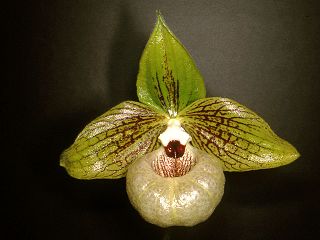
Paphiopedilum malipoense is a species of orchid commonly known as the jade slipper orchid. This hemicryptophyte plant starts blooming in the spring time and has one flower per inflorescence. The plant grows in intermediate to cool conditions. Its flowers have a raspberry fragrance.

Paphiopedilum emersonii, described in 1982, is a species of orchid named after American orchid enthusiast Emerson 'Doc' Charles. The plant blooms from late spring to early summer with one to two flowers per an infloresensce. The plant size is small when compared to other Paphiopedilums. Flowers are fragrant.

Paphiopedilum micranthum, described in 1951, is commonly known as the silver slipper orchid or hard-leaved pocket orchid. It blooms during late winter to early summer with one flower per inflorescence. As opposed to its close sibling Paph. malipoense, the flowers of Paph. micranthum have no fragrance.
Paphiopedilum ooii is named after Michael Ooi, a slipper orchid enthusiast from Malaysia. The plant blooms in the spring to early summer with a spike that can reach up to 2 meters and produce up to 17 flowers.
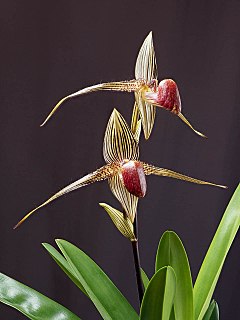
Paphiopedilum rothschildianum, it is commonly known as the Gold of Kinabalu orchid or Rothschild's slipper orchid, is a large sized clear-leafed species of orchid. It blooms with a tall inflorescence with up to six, large flowers. It is unique in the Corypetalum group by holding its petals almost horizontally, giving the flower a very distinctive appearance. The peak flowering period is from April to May.
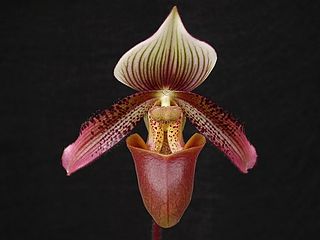
Paphiopedilum ciliolare is a species of flowering plant in the orchid family, Orchidaceae. It is known commonly as the short haired paphiopedilum. It is endemic to the Philippines.

Paphiopedilum fowliei is a species of plant in the family Orchidaceae. It is endemic to Palawan in the Philippines. Its natural habitat is subtropical or tropical moist lowland forests. It is threatened by habitat loss.

Gustav Wallis was a German plant collector, who introduced over 1,000 plant species to Europe, many of which were named after him.
Charles Curtis was an English botanist who was sent by James Veitch & Sons to search for new plant species in Madagascar, Borneo, Sumatra, Java and the Moluccas, before settling in Penang, where he became the first superintendent of the Penang Botanic Gardens.

Paphiopedilum insigne is an Asian species of slipper orchid and the type species of the genus Paphiopedilum. Its name is derived from the Latin insigne, meaning 'badge of honor' due to the magnificent flower. In the 19th century it was very popular among European and American orchid growers, causing it to become very rare in the wild due to over collecting. There are many varieties of it and hybrids with it.
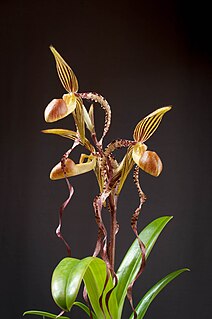
Paphiopedilum sanderianum is a rare species of orchid endemic to northwestern Borneo. First discovered in 1885 by F. Sander's collector, J. Foerstermann, the orchid became renowned for the remarkable length of its petals, which can measure over 1 meter long. Although P. sanderianum has been used as a parent in a number of crosses, none of the resulting hybrids have so far matched the extraordinary lengths of this species' petals. However, soon after the turn of the 20th century, this rare orchid was lost to cultivation and thought to be extinct in the wild, until its rediscovery in 1978 by Ivan Nielson. The wild population of Paphiopedilum sanderianum grows protected in Gunung Mulu National Park.

Phaius tankervilleae, commonly known as the greater swamp-orchid, swamp lily, swamp orchid, nun's-hood orchid, nun's orchid, veiled orchid, Lady Tankerville's swamp orchid or 鹤顶兰 , is a species of orchid native to areas from Asia to islands in the Pacific Ocean. It has large, pleated leaves and tall flowering stems bearing up to twenty five white, brown, mauve and yellow flowers. It was named for Lady Tankerville who owned the greenhouse where the first orchid flowered. It was the first tropical orchid to flower in England.
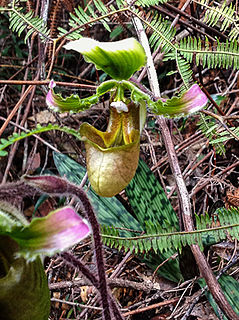
Paphiopedilum robinsonianum is a species of slipper orchid endemic to Sulawesi, Indonesia, where it is known from two mountains in the regency of Central Sulawesi. It is restricted to tropical montane forest habitat at approximately 1400 metres altitude.
Paphiopedilum papilio-laoticus is a species of flowering plant that is part of the subfamily Cypripedioideae. This plant was found in Laos by Sulivong Luangaphay. It is expected to be assessed as a critically endangered species, but scientists are still searching for more specimens in the inaccessible parts of Laos.

















